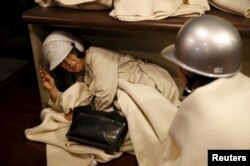Japan's Prime Minister Shinzo Abe has ordered more troops and disaster relief officials to the south of the country where two powerful earthquakes have struck over the span of two days.
At least 19 people are reported to have died in the second quake Saturday morning near Kumamoto city. The Japan Meteorological Agency placed the magnitude of the second quake at 7.0, with an aftershock following at 5.4.
Officials said the death toll could rise as rescue efforts continue.
The disturbance set off a landslide on the island of Kyushu that swept away homes and cut off a highway. A key bridge reaching the village of Minamiaso was destroyed, which could complicate efforts to get aid to one of the worst-hit areas.
The historic Aso Shrine, more than 1,700 years old, suffered a great deal of damage. Several buildings and a gate known as the "cherry blossom gate" have collapsed entirely.
An active volcano in the area also erupted for the first time in a month. It is not clear if the eruption was linked to the earthquake or not.
At least 10 people were killed in the initial tremor that hit the same region Thursday.
The Japan Meteorological Agency issued a tsunami warning for the western coast of the island of Kyushu after the latest quake but canceled it a short time later. Aftershocks are still reported to be rattling the area.
Prime Minister Abe had planned to travel to the area worst-hit after the first earthquake, but he canceled it after the second quake hit.
He has ordered troop reinforcements to the region to "concentrate the government's full capacity into the rescue, evacuation and life-saving operations." He has also said daytime would be the "big test" for rescue efforts, as rainfall and strong winds are in Saturday's weather forecast.
Mobilization
Some 1,600 soldiers are already mobilized in the region along with 2,000 police officers and 1,300 firefighters to help the area recover from the quakes.
The two quakes toppled buildings and also caused a large fire at an apartment complex in Yatsushiro city. Officials say they fear more people are trapped or buried beneath the rubble of buildings.
One bright spot was the televised rescue of a baby who was carried out of the debris of a collapsed home.
More than 100 aftershocks have occurred since Thursday's 6.5-magnitude earthquake.
Not uncommon
Seismologist Robert Geller, a professor of geophysics at Tokyo University, told VOA that the powerful series of quakes in Kumamoto prefecture is not uncommon.
"For example, there was a magnitude 7.3 quake two days before the magnitude 9.0 (or maybe 9.1) Tohoku quake in 2011," he said.
Water service has been disrupted in some areas, forcing residents to haul water from local offices to their homes.
A Kumamoto official said more than 44,000 people spent the night in shelters after fleeing their homes.
The Japan Meteorological Agency said more than 140 aftershocks were reported after the first earthquake.
Government spokesman Yoshihide Suga said there are no apparent abnormalities at nearby nuclear facilities. The epicenter of the first quake was about 120 kilometers northeast of the country's only operating nuclear plant.
Most of Japan's other nuclear reactors remain offline after a 9.0 magnitude earthquake in 2011 triggered a huge tsunami.
Correspondent Steve Herman also contributed to this report.






